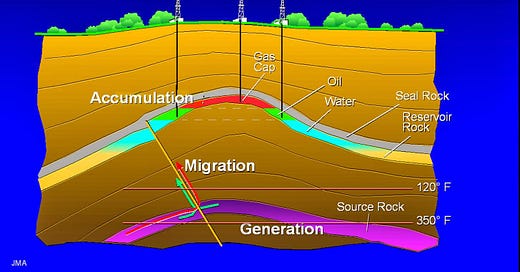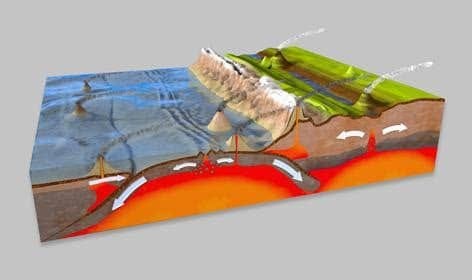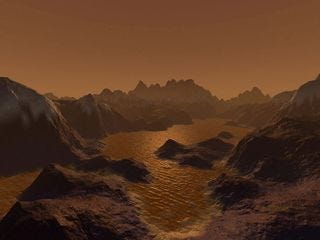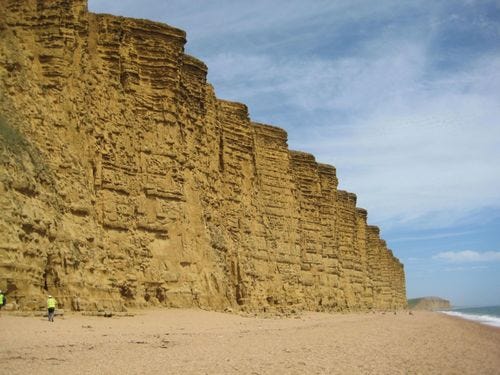Hydro carbons, where do they come from?
We’ve all heard and many believe that oil, natural gas etcetera are old dinosaurs - fossils. While this is somewhat true it is nowhere near that simple.
Hydrocarbons are organic matter from eons ago, this much is true. When this organic matter is heated under pressure it makes a change into hydrocarbons. The gases from this pressure of the earth re condense into hydrocarbons. Unlike when we burn organic matter and allow the hydrocarbons to escape.
The general process is as follows.
With increasing temperature the organic matter produces hydrocarbons. This increase in temperature is simply a set result of burial of the rock.
As hydrocarbons are generated the gasses and liquids plus the remaining organic matter actually try to occupy a greater volume of the rock than the original organic matter occupied. Because this happens to all of the organic particles in the rock and there are literally millions of such particles in a source rock, there is a definite increase in pressure within the rock.
This internal pressure increase due to the generation of hydrocarbons imposes an increased pressure on the fluids that occur in the pore spaces, that exist between the mineral grains. This is called the pore fluid pressure. A number of calculations have been made that show the amount of volume increase. For a source rock with a TOC of 1% wt and assuming a 10% porosity, a volume increase in the organic matter due to hydrocarbon generation will be about 5% of the pore space. Looked at in another way a 1% TOC is a source rock will occupy 2.5% of the volume of the rock and will generate hydrocarbons that occupy an additional 0.25% volume of the rock [Barker, 1980:25].
Clearly if one can cause an increase in the internal pressure within the source rock then a mechanism exists for the expulsion of any gaseous and liquid hydrocarbons that are generated. One reason this idea is acceptable is it is the simplest [Occam's razor].. It states the origin and expulsion of hydrocarbons from a source rock is a natural process that operates as the source rock is buried under more and more layers of sediments. Hunt [1977] pointed out that about 10% or less of the bitumenoids in a source rock need to migrate to produce a commercial accumulation in an associated reservoir. As Barker [1980:25} noted this means the pressuring mechanism only need be about 10% efficient.
https://furiousplanet.blogspot.com/2013/11/hydrocarbon-migration.html
Starting in the deep mantle, they show how the minerals erupt on to the Earth’s surface, become compressed into sediments and then subduct back down into the mantle via tectonic plate movements.
Last week the team presented its findings at a workshop at the Royal Society in London, suggesting that some minerals have been around this deep earth conveyor belt many times, potentially becoming more concentrated on each loop.
So we can now see through decades of research that is readily available that earths is a automatic recycling bin. With plates moving over and under one another, we know that this extreme pressure and heat from earth’s mantle and the friction on these plates extracts / forms hydrocarbons. This not only happens on earth but other planets as well. These same processes are taking place solar system wide.
San Andreas Fault Line - Fault Zone Map and Photos (geology.com)
The plates are slowly moving past one another at a couple of inches a year - about the same rate that your fingernails grow. But this is not a steady motion, it is the average motion.
The hallmark of the San Andreas Fault is the different rocks on either side of it. Being about 28 million years old, rocks from great distances have been juxtaposed against rocks from very different locations and origins. The Salinian block of granite in central and northern California originated in Southern California, and some even say northern Mexico. Pinnacles National Monument in Monterey County is only half of a volcanic complex, the other part being 200 miles southeast in Los Angeles County and known as the Neenach Volcanics.
https://www.space.com/4968-titan-oil-earth.html
Titan Has More Oil Than Earth
Saturn'ssmoggy moon Titan has hundreds of times more natural gas and other liquidhydrocarbons than all the known oil and natural gas reserves on Earth,scientists said today.
Other planets like Jupiter and Saturn are made up of hydrocarbons and Titan a moon of Saturn has more hydrocarbons than earth, in fact it rains hydrocarbons. So it is quite apparent that hydrocarbons are a natural part of our solar system and are not unique to earth.
Why We'll Never Run Out of Oil
https://www.discovermagazine.com/environment/why-well-never-run-out-of-oil
while this link is dated / old the fundamentals have not changed. New oil is constantly being discovered.
How much of the total oil in a field is pumped out?
Please take the poll before reading any further, the answer is below.
https://royalsocietypublishing.org/doi/10.1098/rsta.2012.0320
The average RF from mature oilfields around the world is somewhere between 20% and 40% [1–3]. This contrasts with a typical RF from gas fields of between 80% and 90%. At current production rates existing proven oil reserves will last 54 years [4]. This is probably as good as it has ever been. Improving oil recovery to that typical of gas fields could more than double the time for which oil is available or alternatively allow for increased production rates. This would provide more time for an increasingly energy-hungry world to develop alternative energy sources and technologies.
Pretty amazing, so this is current numbers, what was the recovery rate in say 1940? As technology improves we could go back to these fields and increase the recovery rate. We have well over 100 years of oilfield that have not been extracted at more than 20-40%
Photograph of the Bridport sands that are exposed in cliffs near West Bay, UK. These rocks form one of the reservoirs in the Wytch Farm oilfield that is found near Bournemouth, UK. (Online version in colour.)
Make your own fuel?
HUH? we have the ability for making our own fuel? YES! clean diesel fuel can easily be made and it is economical.
Farmers can buy a $15,000.00 extruder and make their own fuel to run their equipment. Its a easy process and honestly $15,000.00 is so cheap compared to any other farm equipment its ridiculous. Farmers buying the latest and greatest spend well into the 6 figures for just a planter, or a tractor to pull it let alone the 500 k+ for a combine.
PAY BACK TIME ON THE PRESSES
The pay back time calculated on the most popular crop, soybeans. Figuring on a ton of soybeans, the oil yield is slightly over a gallon per bushel or about 34 gallons. If the price for off road diesel is $3.70 your gain is $125.80 per ton. The meal is today's market s a wash in price between raw soybeans to meal per ton. So the net gain minus the oil to run the presses per ton is 3 gallons leaving net gain $114.70 per ton. Figuring on a double six ton presses with commercial kit powered by pto is $15000.00 divided by $114.70 is 130 tons of soybeans. (4290 bushels at 500 lbs hour or 516 hours).
Figuring the large double 20 ton presses process 400 bushels or 400 gallons oil in 24 hours that's 400 gallons times 7.7 lbs per gallon times .58 cents per lbs. equals $1786.40 per day divided by $44000.00 equals 24 days to pay for itself.
Walder Mfg is considered the "guru's " of crushing soybeans from the novelist to commercial production. Walder mfg found that double pressing soybeans is the most efficient way for three reasons.
1. More oil yield per bushel from 3/4 gallon to slightly over a gallon.
2. Higher temperature on the meal creating 49% by-pass protein.
3. The capacity of the pressing triples over single pressing.
Another reason is that the seed coming in and the meal is processed for livestock in one operation as well being compact and easy to adjust because everything is chest height.
Why government and corporate America hates diesel is no secret once you look into it. They do not want any of us getting off their carousel of daily, weekly or monthly purchases. The government LOVES control, if they control transportation they control us. Can you imagine a string of farmers across major highways making and selling diesel? Of course the government would be against this just as they are against farmers selling food direct. Government would not get their cut, corporate America would be put out to pasture also to spend their last years grasping for survival. It would revitalize rural America and once again make us a power house.








